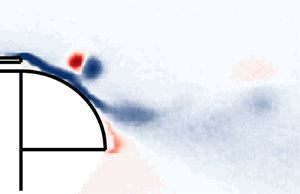Article contents
Unsteady Coanda effect and drag reduction for a turbulent wake
Published online by Cambridge University Press: 27 July 2020
Abstract

We experimentally study the unsteady forcing of the turbulent wake of a three-dimensional blunt body for drag reduction purposes. The forcing is provided by pulsed jets coupled to small flush-mounted curved surfaces and affects the dynamics of the shear layer at separation from the trailing edge of the model. The systematic analysis of the influence of various parameters (forcing frequency and amplitude, radius of curvature  $r$ of the surfaces, free-stream velocity
$r$ of the surfaces, free-stream velocity  $U_0$) on the base drag reduction provides key ingredients to identify proper scaling laws of the mechanisms involved and to model them. The flow reattachment and separation on the curved surfaces result in a boat-tailing of the wake leading to drag reductions of up to
$U_0$) on the base drag reduction provides key ingredients to identify proper scaling laws of the mechanisms involved and to model them. The flow reattachment and separation on the curved surfaces result in a boat-tailing of the wake leading to drag reductions of up to  $12\,\%$ and are noticeably influenced by the time scale of unsteadiness of the forcing. For high frequencies of the order of
$12\,\%$ and are noticeably influenced by the time scale of unsteadiness of the forcing. For high frequencies of the order of  $O(U_0/r)$, strong vortical coherent structures produced by the interaction between the pulsed jets and the separating shear layer promote the interaction of the flow with the curved surfaces. Moreover, the local curvature and pressure gradients across the separating shear layer in the vicinity of flow separation are noticeably modified to result in a further pressure drag reduction for a given forcing amplitude. A simple inviscid-flow model illustrates the peculiar induced effect of these coherent structures on the flow, which explains both the curvature effects leading to additional drag decrease and the saturation in drag decrease for increasing forcing amplitude. The results point to the need for careful combination between forcing frequency and size of the curved surfaces to achieve all the potential in drag reduction of the unsteady Coanda effect. The effort to propose scaling laws and models of the unsteady Coanda effect is a step towards implementing this control strategy at an industrial scale or on different fluid dynamics problems.
$O(U_0/r)$, strong vortical coherent structures produced by the interaction between the pulsed jets and the separating shear layer promote the interaction of the flow with the curved surfaces. Moreover, the local curvature and pressure gradients across the separating shear layer in the vicinity of flow separation are noticeably modified to result in a further pressure drag reduction for a given forcing amplitude. A simple inviscid-flow model illustrates the peculiar induced effect of these coherent structures on the flow, which explains both the curvature effects leading to additional drag decrease and the saturation in drag decrease for increasing forcing amplitude. The results point to the need for careful combination between forcing frequency and size of the curved surfaces to achieve all the potential in drag reduction of the unsteady Coanda effect. The effort to propose scaling laws and models of the unsteady Coanda effect is a step towards implementing this control strategy at an industrial scale or on different fluid dynamics problems.
JFM classification
Information
- Type
- JFM Papers
- Information
- Copyright
- © The Author(s), 2020. Published by Cambridge University Press
References
REFERENCES
- 28
- Cited by

